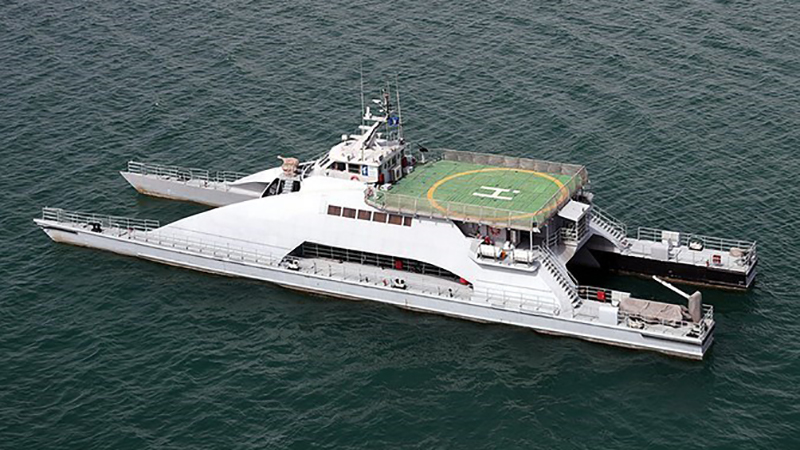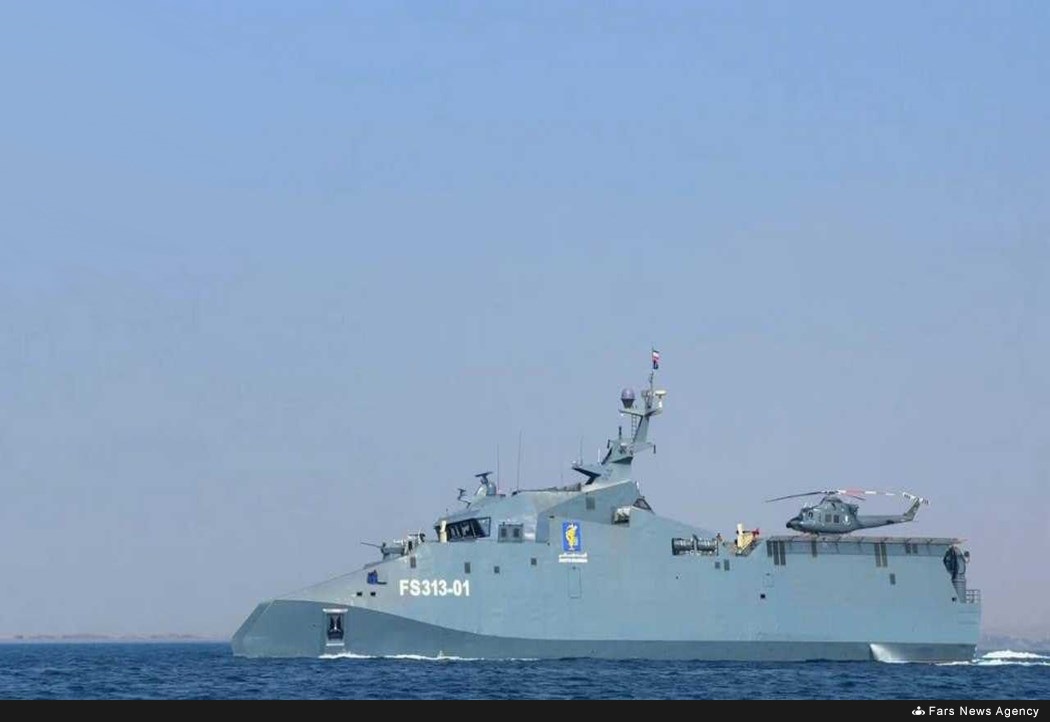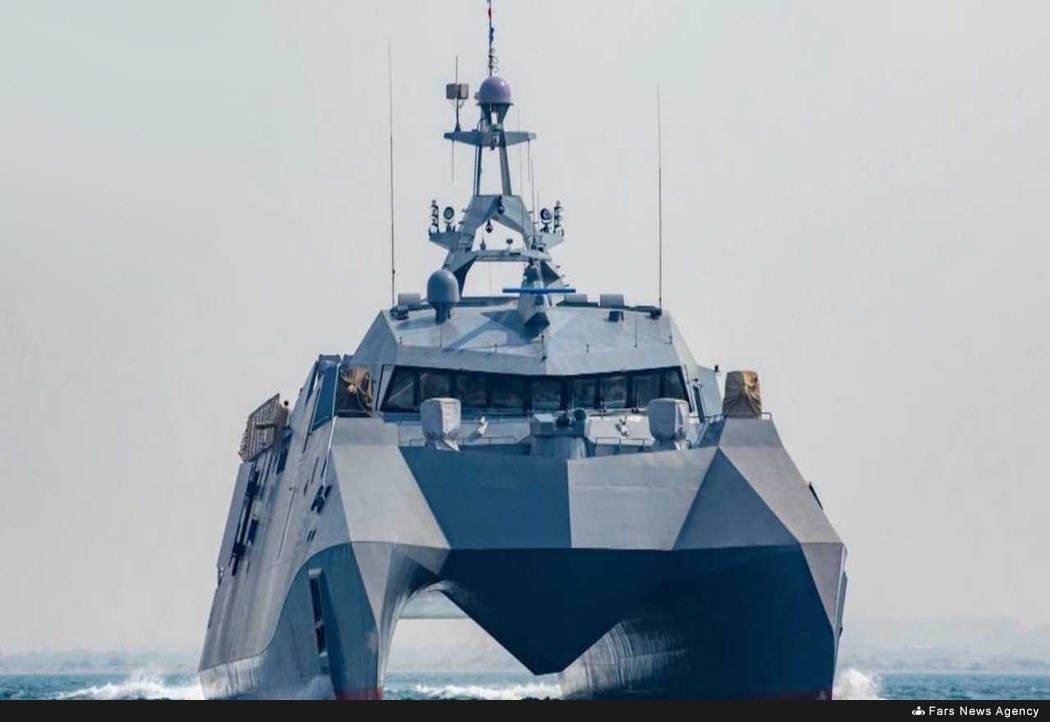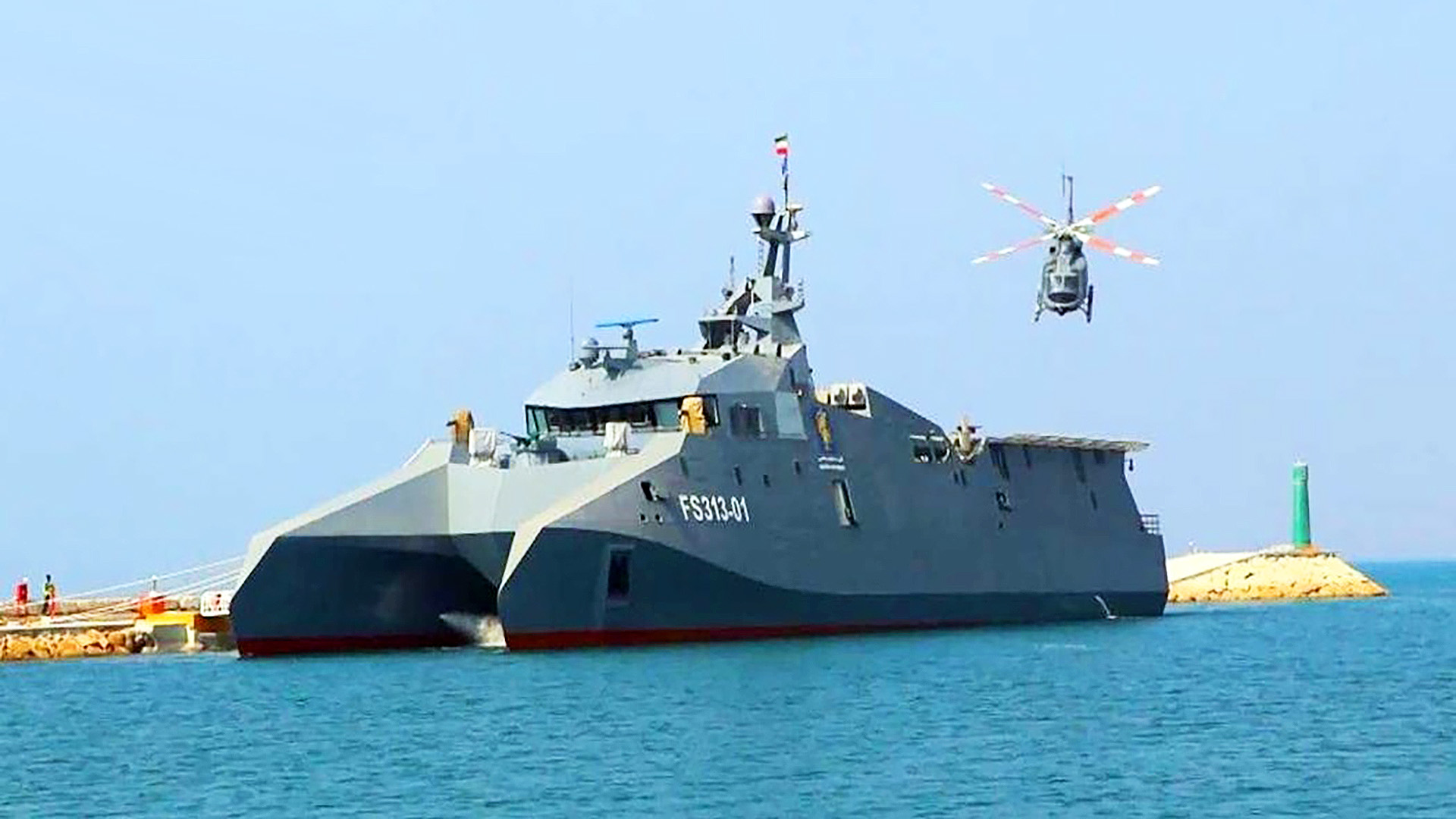Iran’s Islamic Revolutionary Guard Corps Navy, or IRGCN, has revealed a new catamaran missile corvette that is the first Iranian naval vessel equipped with vertical launch system (VLS) cells. It is the second catamaran-type ship of significant size to join the IRGCN’s fleet, but the service claims that this latest addition is brimming with firepower, unlike its predecessor.
Named after the late IRGC General Qassem Soleimani, who the U.S. military killed in a drone strike in Iraq in 2020 and who Iran has named other weapon systems after in the past, the Shahid Soleimani warship was formally unveiled during a ceremony in the southern Iranian port city of Bandar Abbas on Monday.

Shahid Soleimani was built at the Shahid Mahallati Shipyard in Bushehr, Iran, and satellite imagery of early construction began to surface in March last year. At that point, little information had officially been divulged about the ship. The IRGCN’s Shahid Nazeri catamaran, which was commissioned in 2016, was often used in early reports as a point of reference for the future Shahid Soleimani as it was at least known that the vessel would also be a catamaran designed with narrow, widely-spaced hulls.

This new design is far more stout, warship-like, serious naval vessel than the lanky Shahid Nazeri, with Shahid Soleimani also being larger.
Mentioned in the Iranian state news outlet PressTV’s coverage of the event was additional information in regard to the ‘stealth’ role that the IRGCN is claiming Shahid Soleimani will fill. “Radar-evading” technology intended to allow the ship to achieve a lower radar cross-section was prominently noted. Iran has been known to make stealth claims about its ships in the past, and there isn’t much available in the way of credible information to help substantiate these claims. While the vessel may have some low observable-like design cues, exactly how they will actually impact its radar signature is debatable. Iran also says the new vessel will have a higher level of maneuverability compared to other ships of its size, and sports four domestically developed engines for quick deployment and sustainability on long-endurance missions.

After Monday’s unveiling, PressTV also reported on the array of capabilities that the IRGCN claims Shahid Soleimani will offer. While it is necessary to remember that the details they provided may be skewed so as to bolster the ship’s performance specifications, the information could still aid in helping to better understand what those capabilities may shape up to be. To start, Shahid Soleimani, which Iranian media reports is the IRGCN’s largest combatant warship in its fleet, is allegedly the first Iranian vessel overall to be equipped with a vertical launch system (VLS).
What appears to be six readily identifiable VLS cells could be seen in aerial shots of the vessel taken during the unveiling ceremony as well as in concept renderings that were separately released months before the event. Additional covered areas on either edge of the superstructure can also be seen, but the exact configuration of all sets of VLS cells as well as precisely how many there are under the latches isn’t immediately clear.
Iranian media outlets went on to insist that Shahid Soleimani’s VLS is designed to fire unspecified surface-to-air missiles (SAMs) with a purported range of about 93 miles. Independent defense analysts on Twitter, like @AmirlGM , have already begun speculating about what exactly these SAMs could or could not be. He made a point to note that certain Iranian Sayyad SAM types, especially if upgraded, could potentially achieve that 93-mile range shared by Iranian media, as the Sayyad-2, a reverse-engineered first-generation U.S. Standard Missile, boasts a max range of about 74 miles while the newer Sayyad-4 can purportedly reach up to 124 miles.
It’s worth considering, too, that the cells could conceivably be designed for a missile that Iran has not yet unveiled or that has yet to be conceptualized in general. There is also the possibility that long-range SAMs won’t even be used and instead, shorter-range SAMs will be fired from the VLS cells.
As noted earlier, the larger hatches fixed toward each edge of the corvette’s superstructure are also worth pointing out as some Iranian media has suggested that they could house more sizable weapons, such as land attack cruise missiles. Although, no specific mention of types of missiles or exactly how many will be loaded under these larger hatches has been made. There is also the possibility that these bigger hatches house a number of smaller cells also designed for SAMs, though this prospect is just as unconfirmed as the others. It could very well be that these are not even VLS cells at all.
Chief of Staff of Armed Forces Major General Mohammad Bagheri, however, did at least confirm the existence of the VLS when speaking to PressTV.
“This is the Islamic Republic of Iran’s first domestically-developed warship which is equipped with the vertical launch, short-range and medium-range air defense systems,” Bagheri said, going on to add that the ship’s combat system is powered by indigenous software designed with the ability to detect different types of targets and assign them to the ship’s weapons.

Maybe the biggest question has to do with how any missile would be guided or how the ship will detect targets at all. There is no evidence that it sports a radar capable of independently supporting aerial engagements, and especially not long-range ones. It’s possible that it has not been fitted yet, but there isn’t a whole lot of real estate on the ship to do so.
Other weapons that reportedly equip Shahid Soleimani include box launchers capable of firing six anti-ship missiles, a single-barrel 30 mm autocannon with an electro-optical sight for fire control, and what appears to be four 20 mm rotary cannons that may be operated by crewmembers or remotely. In terms of the anti-ship armament, what looks to be canisters for two different sizes of missiles could be seen during the unveiling and were correspondingly identified to be four Ghadir anti-ship cruise missiles and two smaller anti-ship cruise missiles believed to be of the Nasr type.
During the unveiling ceremony, the IRGCN also demonstrated Shahid Soleimani’s ability to carry helicopters after a Bell-412 aircraft was filmed landing atop the ship’s large helipad. Iranian media reports that vertical take-off and landing craft, namely unmanned aerial systems, will be able to launch from this helipad, as well. The ability to launch and control drones from ships and submarines while at sea was recently demonstrated by the Iranian Navy during the introduction of its new ‘drone carrier division,’ further highlighting the country’s strides in domestic weapons development intended for better executing asymmetric operations.
PressTV noted that “sophisticated” but unnamed reconnaissance, electronic warfare, and radar systems make up Shahid Soleimani’s capabilities as well as “self-protection systems, modern communication and telecommunication equipment, various types of encoders, and data links.” Although, it is markedly difficult to corroborate those claims at present with only an outside view of the vessel having been offered during the unveiling ceremony.
Regardless of its actual capabilities, the ship is certainly an impressive addition to the IRGCN’s fleet, which is predominately centered around smaller speedboats and swarming tactics. PressTV did describe one of the ship’s missions as being escorting and protecting IRGCN fast boats in the Persian Gulf where the IRGCN primarily operates, and we have seen its predecessor being used in a similar manner in the past.
Shahid Soleimani will likely act as something of a command-and-control ship for coordinating the activities of drones and/or smaller IRGCN vessels as it also possesses the ability to carry and launch fast-attack boats from its stern, but its high-end punch is something the aging Iranian Navy is likely to be quite jealous of.

While Iran hasn’t alluded to whether or not more of the type will be produced, Shahid Soleimani’s introduction surely underscores the country’s growing desire to boost its maritime capabilities.
Despite Iran’s claims being something to always take with a grain of salt, this vessel is quite impressive and the fact that it is an asset of the IRGC means it is more likely to be used in an aggressive manner than its regular navy counterparts. Its capabilities, size, and relative sophistication could also very well see it operate far from home, potentially taking up station in the Red Sea, which could be problematic for that already tense body of water.
We’ll just have to wait and see not only where the futuristic-looking vessel ends up, but what exactly it looks like when enters operational service.
Contact the author: Emma@thewarzone.com
